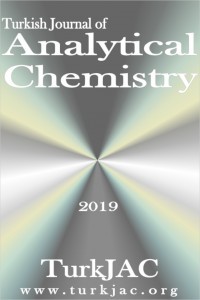Determination of Ethylenediaminetetraacetic acid (EDTA) levels in surface waters by high performance liquid chromatography (HPLC)-Ultraviolet/Visible (UV/VIS) detector
Determination of Ethylenediaminetetraacetic acid (EDTA) levels in surface waters by high performance liquid chromatography (HPLC)-Ultraviolet/Visible (UV/VIS) detector
___
- Referans1. R. Kubota, M. Tahara, K. Shimizu, N. Sugimoto, T. Nishimura, Determination of EDTA in water samples by SPE-gas chromatography/mass spectrometry, J. Water Environ Technol, 8, 2010, 347-353.
- Referans2. P. Kuran, D. Pilnaj, M. Dzurkova, M. Smaha, Method development for determination of EDTA in water by using traditional split/splitless injector – Comparing external and internal standard methods of quantification, IOP Conf Ser: Earth Environ Sci, 221, 2019, 012126.
- Referans3. F.G. Kari, W. Giger, Speciation and fate of ethylenediaminetetraacetate (EDTA) in municipal wastewater treatment, Water Res, 30, 1996, 122-134.
- Referans4. T.P. Knepper, A. Werner, G. Bogenschütz, Determination of synthetic chelating agents in surface and wastewater by ion chromatography-mass spectrometry, J. Chromatogr. A, 1085, 2005, 240-246.
- Referans5. C. Oviedo, J. Rodríguez, EDTA: The chelating agent under environmental scrutiny, Quim Nova, 26(6), 2003, 901–905.
- Referans6. SWR, The Turkish Regulation on the Management of Surface Water Quality, 2012, Official Gazette: 30.11.2012. Number: 28483 (in Turkish).
- Referans7. WFD, Council Directive 2008/105/EC of the European Parliament and of the Council of 16 December 2008 on Environmental Quality Standards in the Field of Water Policy, 2008.
- Referans8. T. Kemmei, S. Kodama, T. Muramoto, H. Fujishima, A. Yamamoto, Y. Inoue, K. Hayakawa, Study of solidphase extraction for the determination of sequestering agents in river water by high-performance liquid chromatography, J Chromatogr A, 1216, 2009, 1109-1114.
- Referans9. K.H. Bauer, T.P. Knepper, A. Maes, V. Schatz, M. Voihsel, Analysis of polar organic micropollutants in water with ion chromatography - electrospray mass spectrometry, J Chromatogr A, 837, 1999, 117-128.
- Referans10. Y. Nishikawa, T. Okumura, Determination of nitrilotriacetic acid and ethylenediaminetetraacetic acid in environmental samples as their methyl ester derivatives by gas chromatography-mass spectrometry, J Chromatogr A, 690, 1995, 109-118.
- Referans11. J.B. Quintana, T. Reemtsma, Rapid and sensitive determination of ethylenediaminetetraacetic acid and diethylenetriaminepentaacetic acid in water samples by ion-pair reversed-phase liquid chromatography-electrospray tandem mass spectrometry, J Chromatogr A, 1145, 2007, 110-117.
- Referans12. ISO, Guide to the Expression of Uncertainty in Measurements. International Organization for Standardization (ISO), Geneva, Switzerland, 1993. https://www.iso.org/standard/ 45315.html, Accessed January 1993.
- Referans13. EURACHEM, The Fitness for Purpose of Analytical Methods: A Laboratory Guide to Method Validation and Related Topics. 2nd edn., LGC, Teddington, 2014. https://www.eurachem.org/ index.php/ publications/guides/mv
- Referans14. AOAC, Guidelines for Standard Method Performance Requirements. Appendix F., Association of Official Analytical Chemists, Virginia, USA, 2016. http://www.eoma.aoac.org/app_f.pdf
- Referans15. J.A. Ferreira, J.M.S Ferreira, V. Talamini, Determination of pesticides in coconut (Cocos nucifera Linn.) water and pulp using modified QuEChERS and LC-MS/MS. Food Chem, 213, 2016, 616-624.
- Referans16. B. Güzel, O. Canlı, Method validation and measurement uncertainty of possible thirty volatile organic compounds (VOCs) presented in the polyethylene present in bottled drinking waters sold in Turkey, J Anal Sci Technol, 11 (44), 2020, 1–17.
- Referans17. B. Güzel, O. Canlı, E. Oktem-Olgun, Gas chromatography method validationstudy for sensitive and accurate determination of volatile aromatic hydrocarbons (VAHs) in water, Cumhuriyet Sci J, 39 (4), 2018, 970–982.
- Referans18. B. Güzel, O. Canli, Applicability of purge & trap GC‐MS method for sensitive analytical detection of naphthalene and its derivatives in waters, J Mass Spectrom 55, 2020, 12.
- Yayın Aralığı: Yılda 2 Sayı
- Başlangıç: 2019
- Yayıncı: Miraç OCAK
Oltan CANLI, Barış GÜZEL, Kartal ÇETİNTÜRK
A Simple and High Throughput Methodology for Simultaneous Determination of Levodopa and Carbidopa
İrem KIRLANGIÇ, Kemal Volkan ÖZDOKUR, Fatma Nil ERTAS
Fast pyrolysis of fig leaves: influence of pyrolysis parameters and characterization of bio-oil
Turgay KAR, Sedat KELEŞ, Zafer EMİR, Kamil KAYGUSUZ
Investigation of Interaction of Bismarck Brown Y- Palladium Complex with AS1411 G-quadruplex Aptamer
Esra BAĞDA, Rümeysa DURAK, Efkan BAĞDA, Didem DUMAN, Ebubekir AYHAN
Nuray DENİZHAN, Selehattin YILMAZ, Gülşen SAĞLIKOĞLU, Emrah KILINÇ, Çiğdem YENGİN, Fatma Gülay DER
Yunus Emre KAMIŞ, Bülent AKAR, Cemallettin BALTACI
Erdem KUZUCANLI, Ebru ÇUBUK DEMİRALAY, Yaşar Doğan DALDAL, Zehra ÜSTÜN, İlkay KONÇE, Abbase Güleren ALSANCAK
Electroanalytical Analysis of Guaifenesin from Pharmaceuticals on Boron Doped Diamond Electrode
Fatma AĞIN, Gökçe ÖZTÜRK, Dilek KUL
Hakkı İsmail KAYA, Ceren BOGUSLU, Esra KABAK, Cagla AKKOL, Ece Tuğba SAKA, Selcen ÇELİK UZUNER
